- SAP Interview Questions
- SAP MDG Interview Questions
- SAP PS Interview Questions
- SAP C4C Interview Questions
- SAP ISU Interview Questions
- SAP Analytics Cloud Interview Questions
- SAP CO Interview Questions
- SAP CPI Interview Questions
- SAP VIM Interview Questions
- SAP SCM Interview Questions
- SAP IBP Interview Questions
- SAP RAR Interview Questions
- SAP TM Interview Questions
- SAP CPI Architecture
- What is SAP Transportation Management ?
- What is SAP SCM?
- What is SAP PO - SAP Process Orchestration Architecture
- SAP PO Interview Questions
- What is SAP EDI?
- What is SAP Vistex?
- What is SAP Cloud Platform?
- What is SAP MRP - SAP MRP Tutorial
- What is SAP BTP?
- What is SAP Fieldglass?
- What is SAP C4C?
- What is SAP ISU
- What is SAP Solution Manager?
- SAP Analytics Cloud Tutorial
- SAP HCM Interview Questions
- What is SAP APO?
- SAP CPI Tutorial - A Beginner’s Guide
- What is SAP CAR?
- What is SAP PS - SAP PS Tutorial
- What is SAP IBP?
- What is SAP CPQ
- What Is Sap Netweaver
- What Is SAP BRIM
- What is SAP Master Data Governance (MDG)?
- What is SAP VIM?
- SAP MDG Architecture
- What is SAP MDG
- SAP MDG Tutorial
- SAP TRM Interview Questions
Establishing an organization requires an efficient team that manages the entire business process. So, managing the team is a crucial part of any enterprise and organization. However, due to the growing size of the organization, management of human resources becomes challenging. That is where the SAP HCM comes into the picture to help you manage all your talent and human resources with ease.
In this tutorial, we will walk you through a straightforward tutorial on SAP HCM so that you can easily learn how to use it for your organization. Let’s start with no more waiting.
Table of Contents
- Overview of SAP
- What is SAP HCM?
- Components in SAP HCM
- What are Infotypes in SAP HCM?
- Organization Management
- Personnel Administration
- Time Management
- Payroll Management
- Employee Benefits
- SAP HCM Universal Work List
- What is SAP SuccessFactors?
- History of SAP SuccessFactors
- Features of SAP SuccessFactors
- SAP HCM Deployment Models
- How to access the SAP HCM Free Trial?
- Frequently Asked Questions
Overview of SAP
SAP(System, Applications, and Products) is a German Multinational Company that provides leading Enterprise Software Solutions such as Enterprise Resource Planning (ERP), Customer Relationship Management (CRM), Supply Chain Management (SCM), Cloud and Database, Data Analytics, and other solutions for all types of organizations, from small to big ones.
|
Learn more about the Components and features of SAP HCM in our SAP HCM Training thoroughly addressed by our trainers |
It provides On-Premise solutions such as SAP Business Suite, SAP ERP Central Component (ECC), SAP Customer Relationship Management (CRM), SAP Supplier Relationship Management (SRM), etc. Along with this, it also provides Cloud Solutions such as SAP S/4HANA Cloud, SAP Ariba, SAP Integrated Business Planning (IBP), SAP SuccessFactors, and many more.
Now let us look into the SAP HCM that helps us manage our Human Resources.
What is SAP HCM?
SAP HCM stands for SAP Human Capital Management and is one of the core products of SAP that provides the core functionalities of Administration, HR, Talent, and Payroll Management. It is also called SAP HR (SAP Human Resources). SAP HCM is made up of various submodules, each responsible for a particular enterprise task related to Human Resources.
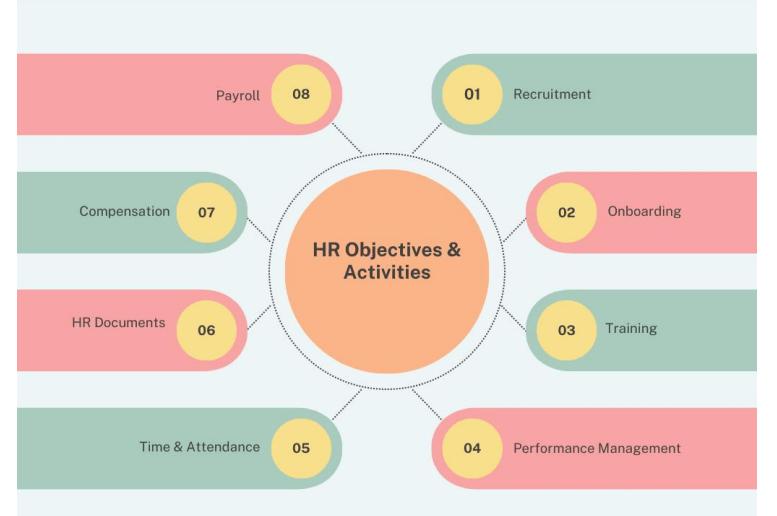
The main utility of the SAP HCM is that it provides ready-to-run functionality for Human Resource Management. Thus, organizations do not need to develop any application from scratch. They can use the SAP HCM directly to efficiently manage their workforce and human resources.
Now let us see the components of SAP HCM for a more detailed understanding
Components in SAP HCM
SAP HCM has various components called sub-modules that are used for human resource management and workforce planning. These sub-modules are interrelated with each other to serve the workforce planning within the organization. The description of various Modules of SAP HCM is stated below.
- Organizational Management: It includes Personnel development, cost planning, and event management.
- Time Management: Various features such as time recording, attendance, schedule, shift management, etc. are included here.
- Personnel Administration: Personnel Administration includes personnel and organizational structure, Infotypes, integration with time and payroll, etc.
- Payroll: It provides functionalities such as payroll types, payroll group configuration, primary and secondary wages, gross pay, bonuses, etc.
- Recruitment: Recruitment includes hiring an employee, maintaining HR master data, etc.
- Training and Event Management: You can use this module for the skill development of employees through identifying training needs, scheduling training, training cost management, etc.
What are Infotypes in SAP HCM?
Every software system is made up of the building blocks that store or process the information. In SAP HCM, the Infotypes act as the building blocks. The Infotype stores the data for all administrative or personnel actions due to which they are called small units of information in the SAP HR System.
The components of Infotypes are of the following types:
- Structure: The structure of the Infotype is like a container in which similar types of records are stored. It contains various information such as first name and last name, birth date, identity number, etc.
- Data Entry: When the data is entered in the Infotype, it is checked using the pre-defined values to ensure accurate information in the database.
- Time Dependency: At the time of info type updation, the old data is not removed from the system. Instead, its time is delimited which means the end date of object type is set to the open-ended period. For example, if the position is updated to a new position on 31 Nov 2023. The end date will be set to 31.11.9999 instead of 31.12.2023. Thus, old data is kept for evaluation purposes.
Along with the Infotype Management, you can also manage the subtypes of an Infotype. For example, for an Infotype named ‘Address,’ the Subtypes can be Permanent Residence address, Temporary address, and Home address.
Organization Management
Before planning the workforce, you first have to define the structure of your enterprise so that you can assign the roles and responsibilities to various personnel. The Organization Management submodule allows us to manage the enterprise structure and analyze the organization plans.
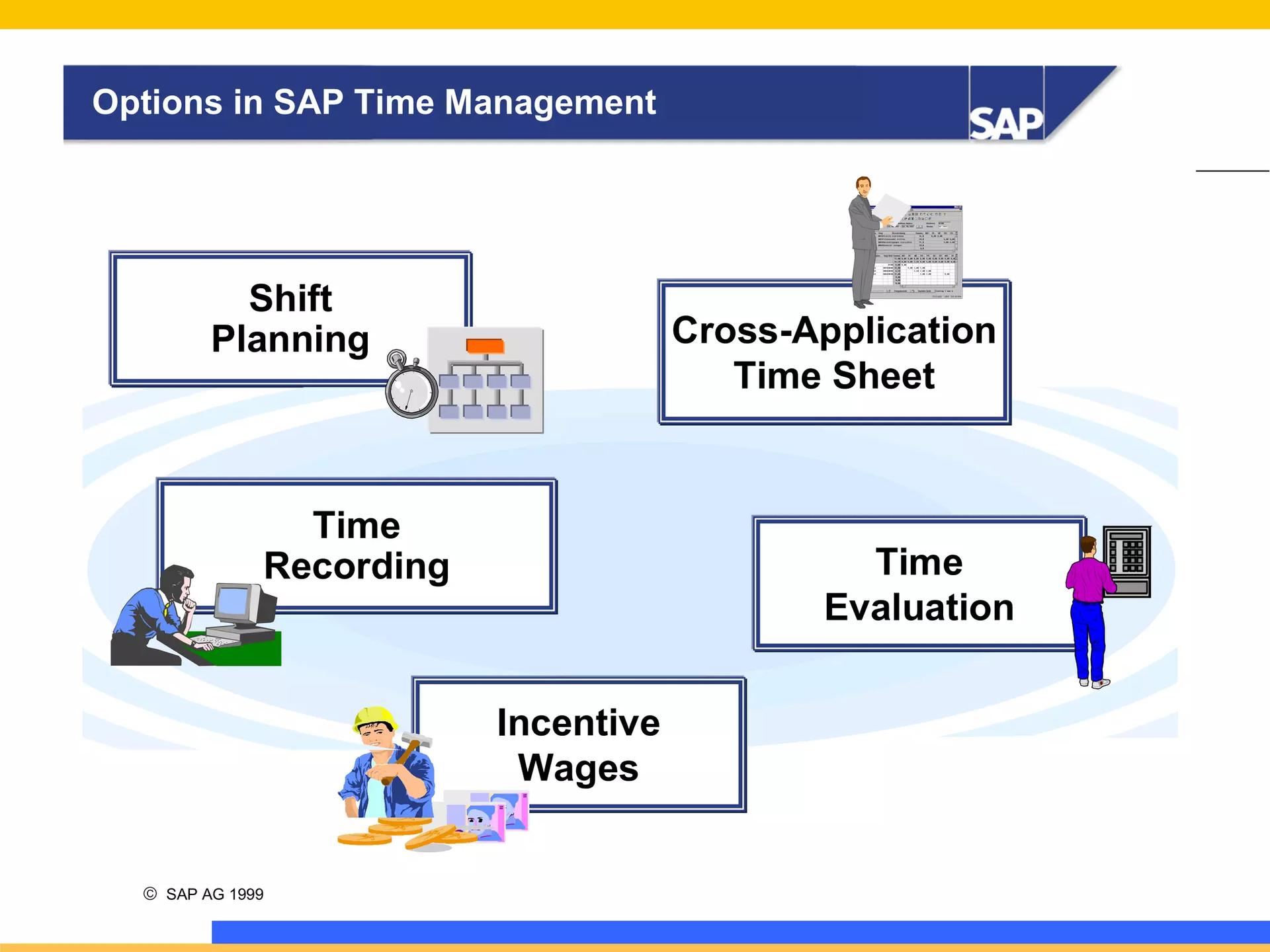
Here, we can configure the settings required for defining the enterprise structure and personnel cost planning. In this module, the structure of an organization is represented through a blueprint called ‘Plan.’ Thus, We can define different versions of the plan to configure multiple organization plans at a time. The T-Code for setting the plan version as active is OOPV.
The key terms related to this module are:
- Object Types: The Organizational Plan includes various objects that define the grouping of similar data together. Each object type is identified using a unique key called the Object Key and is linked to other objects via some relationships.
- Relationships: They are the links between various object types in an organizational unit.
- Validity: The start time is recorded at the time of creation of the object type that determines the lifetime of an Object Type. Thus, the validity of the Object Type can be easily defined,
- Number Ranges: The admins can assign the different numerical ranges to various object types. For example, the Sales Department would have a number ranging from 1000-1999 so that the sales manager position can be identified by a number between 1000 and 1999.
Personnel Administration
This Module is used to manage the information that is stored and updated for each employee in the HR System. Simply put, Personnel Administration is needed for managing the personnel information in the System. Hence, it is important to manage the employee master data, organization structure, payscale structure, and hiring and onboarding activities.
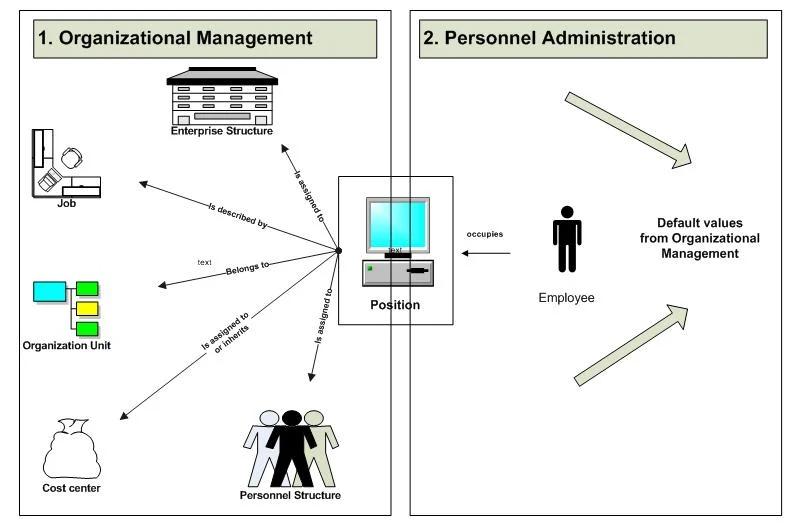
The various functions of this module are discussed below.
- Employee Master Data: The Employee Master data includes various pieces of information about the employee such as name, address, contact information, and more. This information is stored in the Infotypes through various personnel actions.
- Personnel Actions: Personnel Actions are the actions that require data to be entered into the HR system. Some examples of Personnel Actions are hiring a new employee, terminating an employee, etc.
- Administrative Structure and Organizational Structure: We can create an administrative structure that includes the object types such as Employee group, Employee subgroup Payroll area, etc. We can also create an Organizational Structure that consists of a Position, Job, and Organizational unit for an employee.
Time Management
This module allows the users to manage their time and track their schedules across the various departments. The main utility of this module is seen in the estimation of profit and loss, human resource costs, and many other time-related metrics of the project. We can easily calculate the number of hours worked on a project, leave and absence, holidays, business trips, etc.
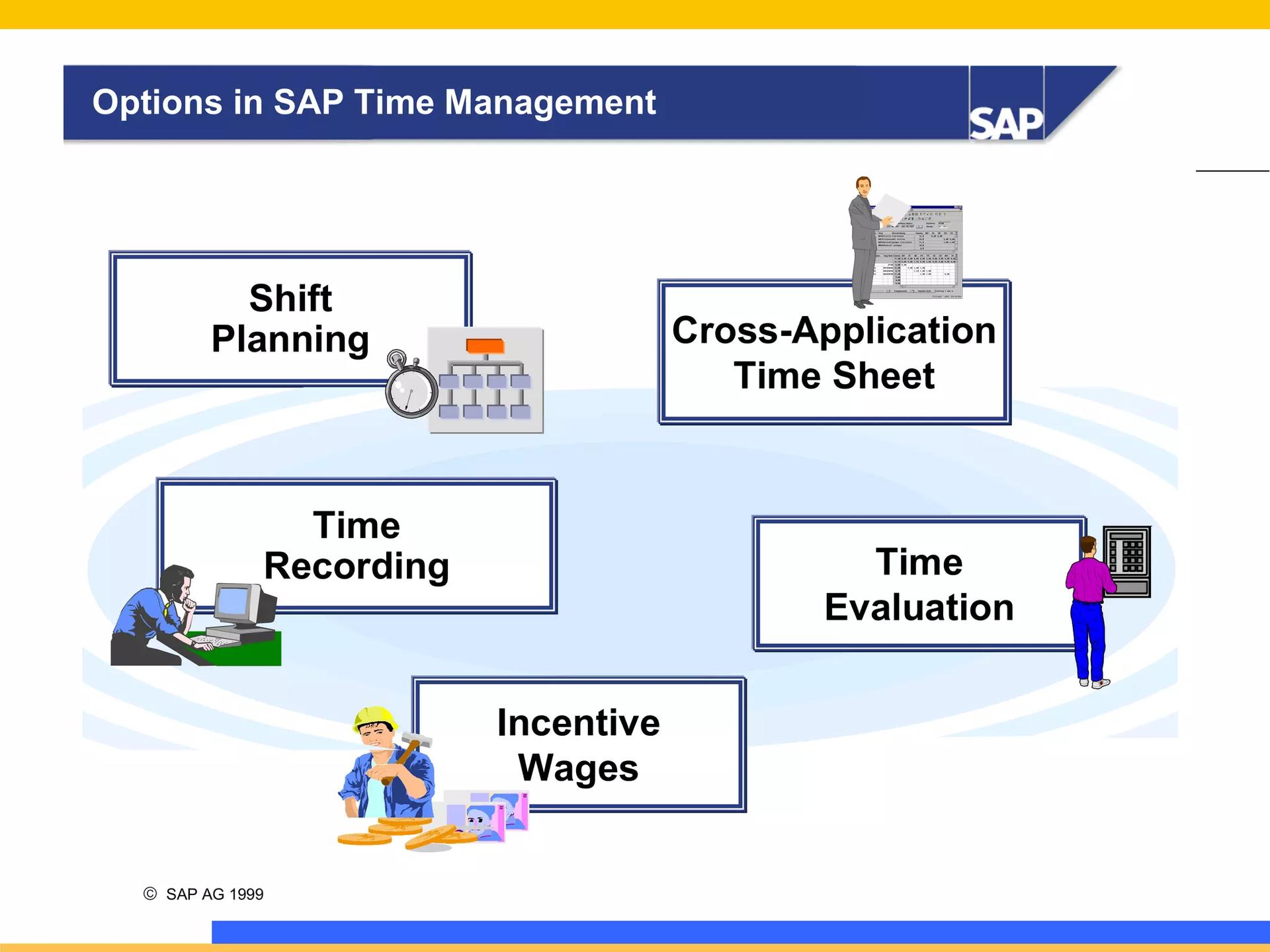
Using this module, we can easily manage the daily work schedule, public holiday calendar, and Attendance Absences of the employees. Within the organization, the employees may take leaves that are preallocated to them or they take the unplanned leaves. Hence, it is also important to keep track of employees availability. The following are the terms related to this module.
- Quota Driven Absence: It means the leaves included as per the allocated limit like the Casual Leaves and Earned Leaves.
- Non-quota-driven absences: Opposite to quota-driven absences, these are unplanned leaves such as leave without pay.
- Positive Time Recording: Positive-time recording means the automatic recording of the time-related activities in the background. It is generally used in the daily attendance, absence, and overtime.
- Negative Time Recording: It includes the manual recording of time-related activities like posting of absence for wage deduction, attendance validation
Payroll Management
Payroll is one of the most important parts of workforce planning. This module processes the payroll of the employees. It calculates the gross pay and the net pay using the different wage types which contains payment for each employee and deductions for a payroll period. It can be integrated with Personnel Administration, Time Management, Wages, and Accounting.
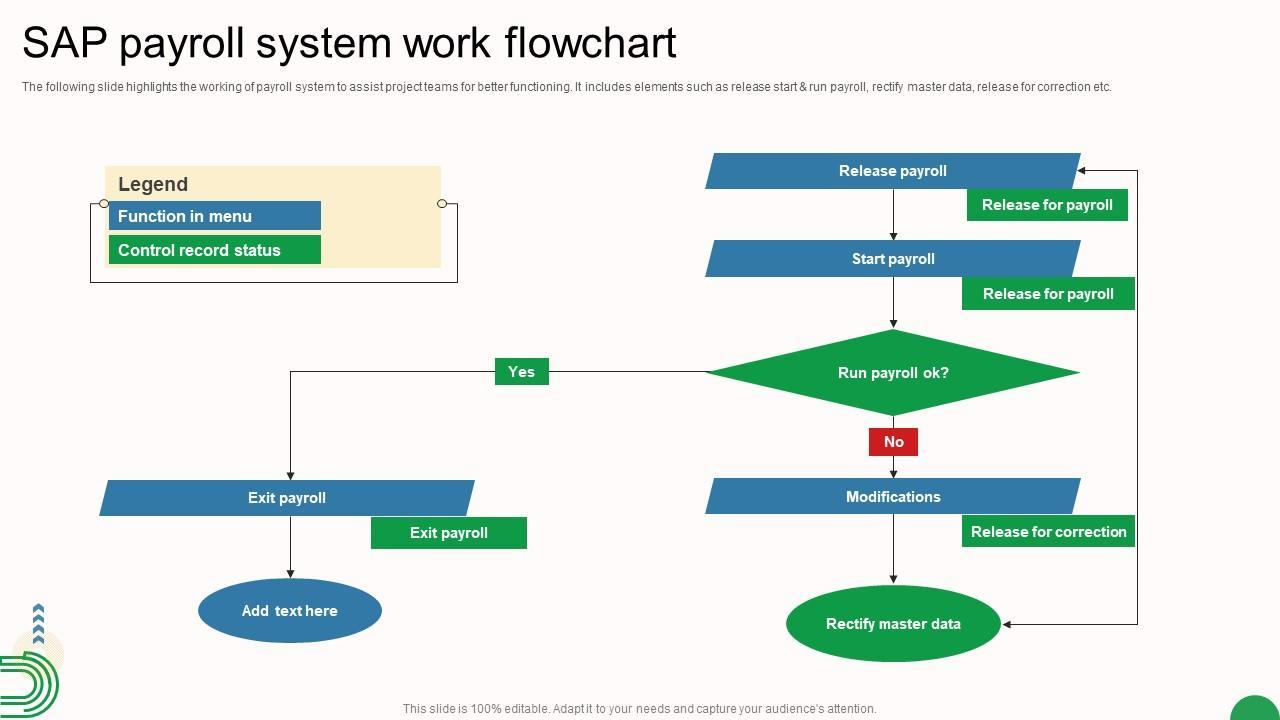
In the Payroll Module, Also, you can also use the master data from the personnel administration for payroll management. In this module, the Incentive Wages Component can process the payroll directly. The main component of this module is the Payment Control Record that executes the payroll processes in the HR System. It locks the master data during the payroll processing to prevent changes during the payroll processing.
The various terminologies related to this module are:
- Payscale Structure: It consists of the Pay Scale Area which defines the geographical area where the collective agreement is valid. It also has the Pay Scale Type, Pay Scale Group, and Level to identify the criteria to classify the job.
- Primary Wage Type: Primary Wage Type is the wage type for which the info type accepts the data as input. It is of two types namely the Time Wage Type and Dialogue Wage Type. The Time Wage Type combines time management and payroll.
- Secondary Wage Type: It is the additional wage type that has an amount, rate, or number. Examples of this wage type are bonuses, allowances, or special deductions.
Employee Benefits
In this module, the custom benefits are managed for the employees. This component plays an important role in retaining the employee by enrolling them under various benefits. This process of including the employee under the benefit scheme is called Enrollment. Enrollment can be of different types such as Open Enrollment Offers, Default Enrollment Offers, Automatic Enrollment Offers, and Adjusted Enrollment Offers.
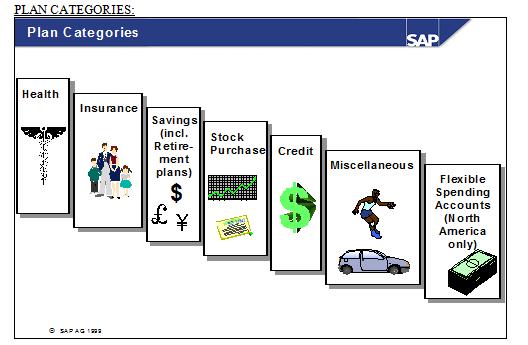
The Benefit areas in the HR Module are independent of each other and are configured separately from each other.
The various components of Employee Benefits are shown in the below table:
|
Benefit Category |
Benefit Plan Type |
Benefit Area |
|
Health Insurance |
Medical |
National |
|
Retirement |
401(k) |
International |
|
Time Off |
Vacation |
Regional |
|
Wellness |
Gym Membership |
Local |
|
Education |
Tuition Reimbursement |
Global |
SAP HCM Universal Work List
It is a centralized tool that provides a unified view of different workflows in the SAP HCM system. It is generally integrated with the HR Administrator and Manager portal roles. Also, it is used to group the different workflow tasks that are relevant for the administrator. Suppose the HR Administrator wants to review the appraisals of the employees.
Using the Universal Work List, HR can access detailed information about the employee’s performance, ratings, comments, and reviews from seniors. Thus, Universal Work Lists simplifies the different HR processes from different applications under a single interface.
Now, let us see another powerful form of the SAP HCM System, which is called the SAP SuccessFactors HXM Suite.
What is SAP SuccessFactors?
While learning about the SAP HCM module, you might get confused with the SAP HCM and SAP SuccessFactors as they both deal with Human Capital Management. Thus, it is important to understand the difference between the two. Let us explore this in a detailed way.
SAP SuccessFactors, also called SAP SuccessFactors HXM is a cloud-based HCM Solution provided by SAP for the core HR and payroll, talent management, and many other purposes. The HXM here means Human Experience Management which allows the organizations to manage the workforce with modern cloud-based features and AI-driven capabilities.
SuccessFactors has various components such as Employee Central, Performance & Goals Management. Compensation, Variable Pay, Learning, Onboarding/ Offboarding, Payroll, Time Management, Reporting and Analytics.
On the other hand, the SAP HCM is generally used as an On-Premise Solution for workforce planning and talent management. SAP HCM follows a client-server architecture in which the server provides all the features requested by the client machine.
History of SAP SuccessFactors
SuccessFactors was founded by Lars Dalgaard in 2001. It started as a SaaS Tool for performance management. Later on in the year 2012, SAP acquired and renamed it ‘SAP SuccessFactors and made a fully functional cloud-based HCM Platform. Its latest version came in 2019 and includes various functionalities such as the mobile app, SAP SuccessFactors Employee Central Service Center, the recruiting solution, and many more. It is now known as one of the most popular solutions for Human Capital Management.
Features of SAP SuccessFactors
Core HR and Payroll
The organization can serve its employees in terms of HR, payroll, time tracking, admin management, HR service delivery, and many more using the SAP HXM. It allows them to standardize the HR Processes and Payroll transactions using the flexible Human Resource Information System (HRIS). Also, employers can manage the employee content with simplified access with centralized management.
Talent Management
SAP HXM also enables us to address talent management using talent intelligence, recruiting, paperless onboarding, performance, compensation, learning, succession, and development. Thus, all the recruiting activities can be streamlined and automated to address the various talent requirements in the organization.
Employee Experience Management
The organization can efficiently involve their employees through experience management so that they can easily identify what to do and properly listen to their feedback. The digital workplace helps us to enhance the individual candidate experience which allows the workforce to easily adapt to the changing requirements of the Projects.
People Analytics
SAP HXM provides the features of AI-driven recommendation due to which we can carefully analyze the performance of both the HR Processes and the workforce. Hence, the company-wide performance can be easily gathered to extract some meaningful insights from them to ensure continuous improvement. This helps us to deliver the right talent at the right place and at the right time.
Sales Performance and Management
SAP HXM helps us to maximize sales performance through structured and automated incentives or compensation management. This approach of optimizing the sales outcomes with better planning saves time and cost and speeds up growth and operational efficiency.
SAP HCM Deployment Models
There are various modes in which the SAP HCM Suite can be deployed and used. Thus, the HCM Solution of SAP is flexible as per the requirement of workforce planning. The various deployment modes of the SAP HCM are as follows.
- Talent Hybrid: This deployment mode is applicable if you want to use the on-premise SAP ERP or SAP S/4HANA for the HR processes and Talent Management along with the SAP SuccessFactors HCM Suite.
- Core Hybrid: Under this option, the cloud-based Employee Central is used but payroll or time management runs on the SAP ERP or SAP S/4HANA. Here, it does not matter whether AP SuccessFactors HCM Applications are used or not.
- Full Cloud HCM: This made entirely uses the SucessFactors HCM Suite which is suitable for the new users as they do not have any on-premise record.
- Side-by-Side: This mode runs the SAP ERP HCM and Employee Central in parallel as a dual system. These systems can be integrated and synchronized with each other. It runs the parallel system while keeping the master system identities isolated for a particular group of employees.
How to access the SAP HCM Free Trial?
- Step 1: Go to the official website https://www.sap.com/india/index.html and select the ‘Trial and Demo’ option in the Product dropdown as shown below.
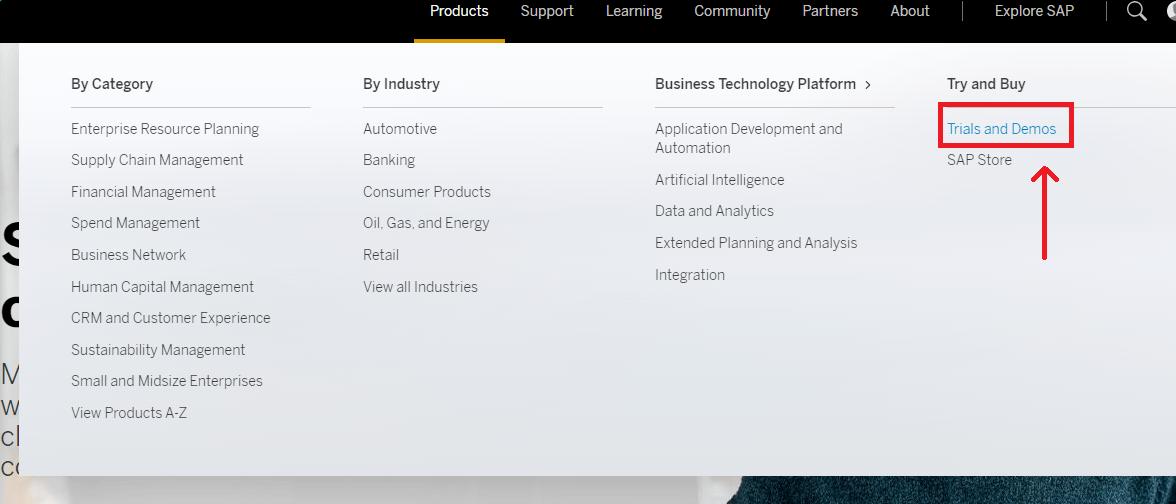
- Step 2: Under the ‘Guided Experience,’ sections, select the ‘Workforce Planning’ option.
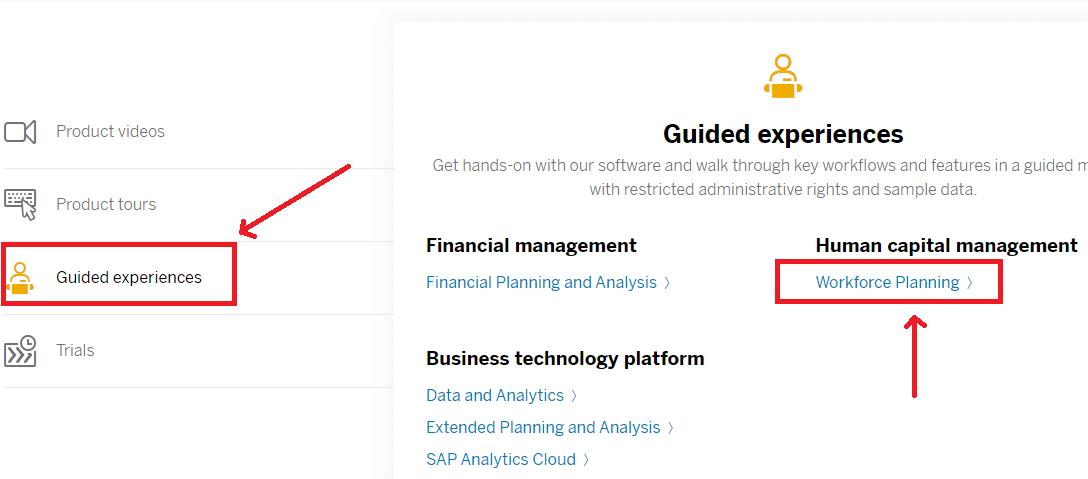
- Step 3: Click on the ‘Start Now’ button to continue.
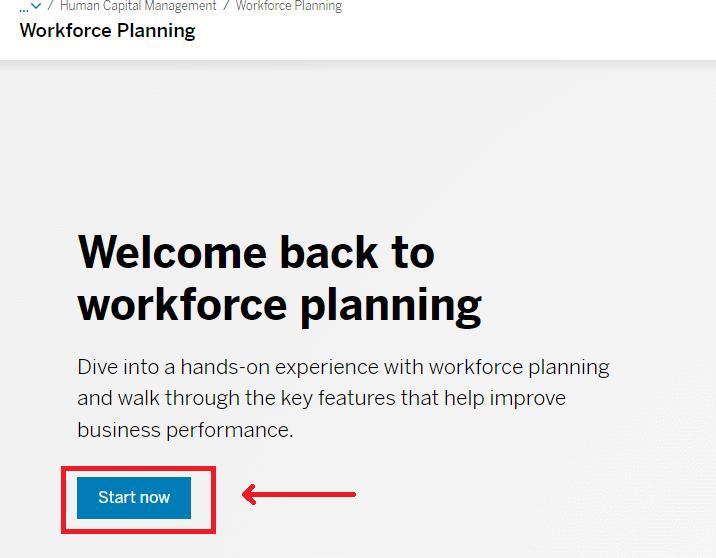
- Step 4: The credentials are visible in the pop-up as shown below. Click on the button at the bottom section of the pop-up.
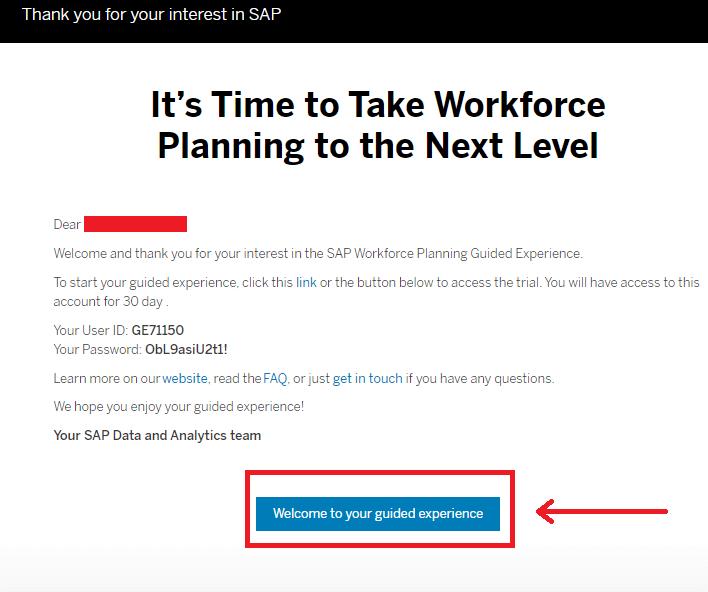
- Step 5: The Workforce Planning Trial Console appears as shown below.
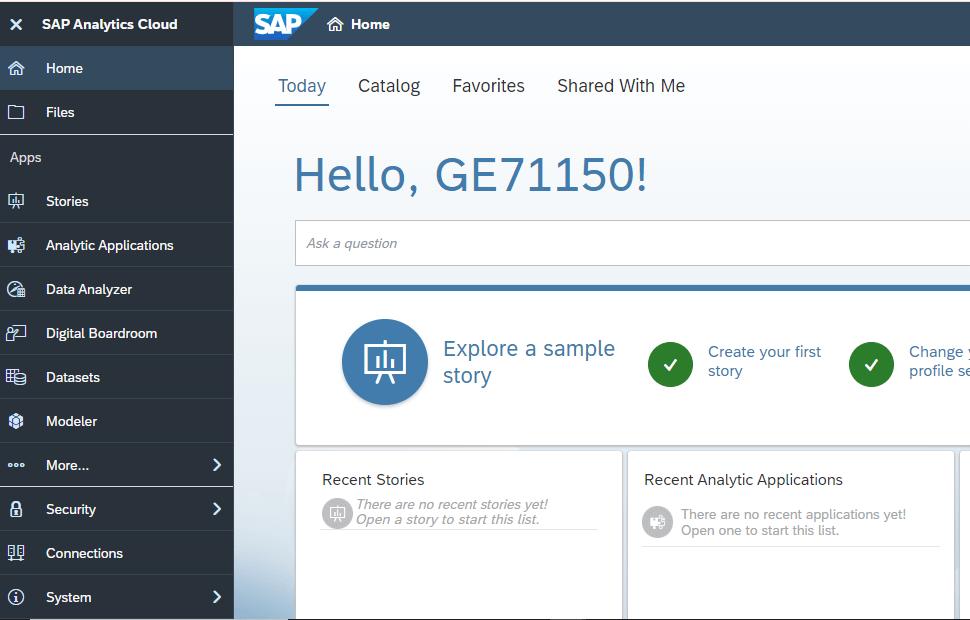
- Step 6: You can now easily create various dashboards and interfaces for your workforce planning and human capital management. For example, the analysis for Employee Performance can be created under the stories section as shown below.
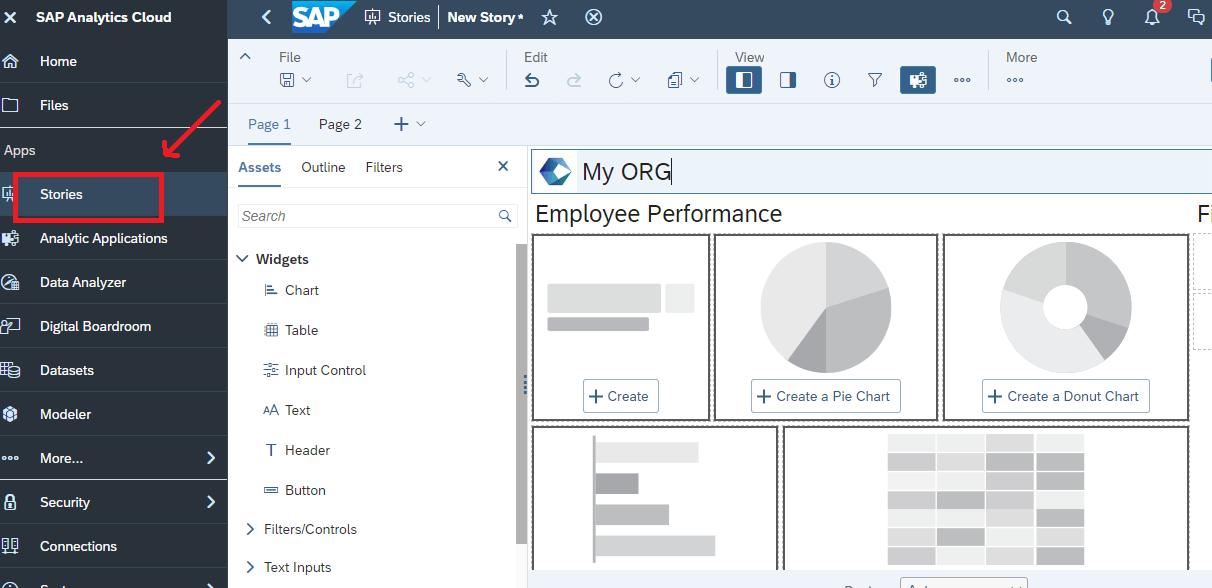
Frequently Asked Questions
What is the difference between the HCM and HR?
Both the terms HCM and HR are related to Human resource management. However, when it comes to the applications, there is a slight difference between the two. SAP HR is the core module of SAP and can be created using the customized ABAP Codes. But, HCM is the business suite and can be accessed using the web-based tool.
Is there any SAP Certification for the HCM Module?
SAP provides various certifications for HR and Workforce Planning such as HCM Certification, and SuccessFactors Certifications. We recommend visiting the official certification page of SAP at https://learning.sap.com/search?query=HCM+certification&page=1. You can choose the certification according to custom enterprise requirements.
Does SAP Provide any training support for SAP HCM?
SAP supports wide support for the HCM Training as well as the documentation. You can visit https://training.sap.com/trainingpath/Applications-Human+Capital+Management+(HCM)-SAP+ERP for the HCM Training. Along with this, it also provides documentation support at https://help.sap.com/docs/portfolio-category/HR_AND_PEOPLE_ENGAGEMENT.
What is the SuccessFactors Recruiting Software?
SAP SuccessFactors Recruiting Software is the application by SAP that helps the users in the recruitment processes such as hiring, and onboarding. It offers various features such as Global Talent Sourcing, Candidate Experience, and Relationship Management. Applicant Tracking System(ATS). Its pricing starts at USD 31.92 per user per month. You can get more information about it at the official website https://www.sap.com/products/hcm/recruiting-software.html/.
Is there any community support for SAP Solutions?
You can access the community support at the official forum https://community.sap.com/ to resolve any doubts or ask queries from the domain experts and community members. You can also find help regarding the various SAP Products.
Conclusion
In conclusion, SAP HCM is a popular solution for Core HR Processes such as Recruiting and Onboarding, Talent Management, and Workforce Planning. It follows a modular structure in which various modules such as Administrative, Core HR, Payroll, and Time Management are used for the various HR and Workforce processes. Therefore, it becomes important to learn about the SAP HCM Module so that you can easily help your organization to efficiently manage and utilize the enterprise talent pool.
You have now gained sufficient information about the SAP HCM. Go ahead and experience the next-level Human resource management using SAP Solutions.
 On-Job Support Service
On-Job Support Service
Online Work Support for your on-job roles.

Our work-support plans provide precise options as per your project tasks. Whether you are a newbie or an experienced professional seeking assistance in completing project tasks, we are here with the following plans to meet your custom needs:
- Pay Per Hour
- Pay Per Week
- Monthly
| Name | Dates | |
|---|---|---|
| SAP HCM Training | Dec 27 to Jan 11 | View Details |
| SAP HCM Training | Dec 30 to Jan 14 | View Details |
| SAP HCM Training | Jan 03 to Jan 18 | View Details |
| SAP HCM Training | Jan 06 to Jan 21 | View Details |

Madhuri is a Senior Content Creator at MindMajix. She has written about a range of different topics on various technologies, which include, Splunk, Tensorflow, Selenium, and CEH. She spends most of her time researching on technology, and startups. Connect with her via LinkedIn and Twitter .






